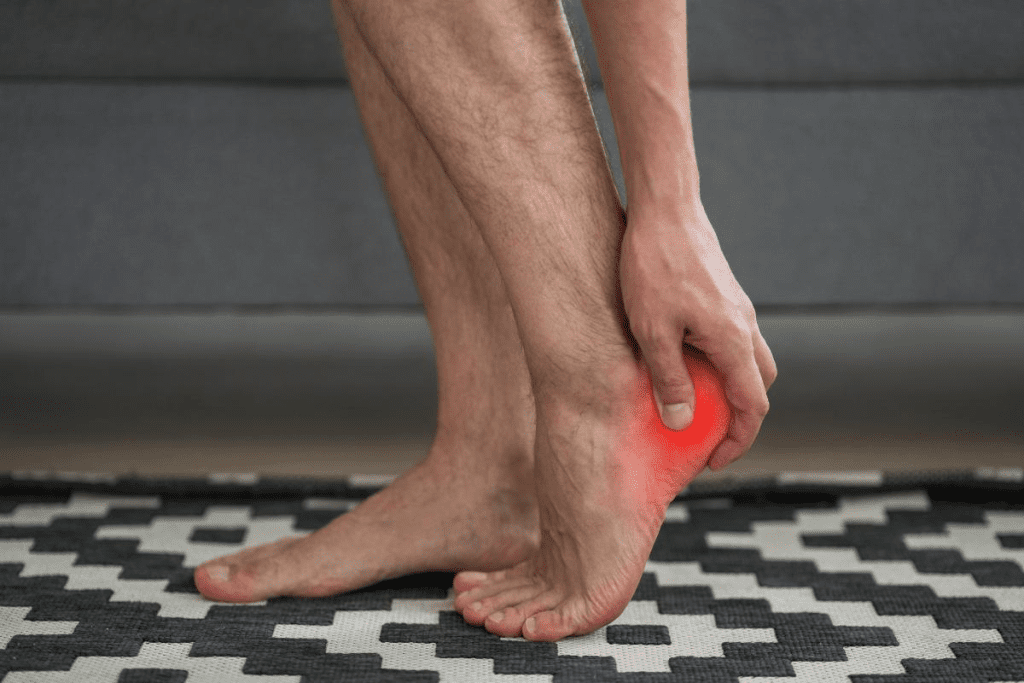Diagnosing appendicitis can be tough, but a simple test called the tiptoe or heel drop test is getting more attention. The tiptoe test involves standing on tiptoes and then dropping down onto the heels. This can help doctors check for peritonitis, a common problem with appendicitis.

We look into what this test is, its history, and why it matters. The tiptoe test, also known as the heel-jar test, helps find peritonitis linked to acute appendicitis.
Key Takeaways
- The tiptoe test is a simple diagnostic tool for assessing suspected appendicitis.
- It involves standing on tiptoes and dropping down onto the heels to check for peritonitis.
- This test is also known as the heel drop or heel jar test.
- Early diagnosis of appendicitis is key to effective treatment.
- The tiptoe test can help doctors figure out if peritonitis is present.
Understanding the Tiptoe Test for Appendicitis

The tiptoe test, or Markle sign, has been used in clinics to check for appendicitis. It has been used for over 40 years. It’s known for its ability to spot peritonitis, a serious problem linked to appendicitis.
Definition and Alternative Names
The tiptoe test is also called the Markle sign and heel drop test. These names are used in medical papers. The test is simple but helps find pain signs that show peritonitis.
Historical Development of the Test
George Bushar Markle IV introduced the tiptoe test in 1973. It was a big step in diagnosing appendicitis. The test is now a common tool in medicine because it’s easy and works well.
“The heel drop test is a valuable tool in the diagnosis of acute appendicitis, providing a simple yet effective means to assess for peritonitis.”
Basic Mechanism of Action
The tiptoe test checks how a patient reacts to certain movements. If a patient with peritonitis does the tiptoe or heel drop, it can make the pain worse. This is a key sign for doctors to diagnose appendicitis and start treatment.
Knowing how the tiptoe test works helps doctors better diagnose appendicitis. This leads to better care for patients.
How to Perform the Markle Sign Test Correctly
The Markle sign test is a simple yet effective way to diagnose appendicitis. It involves a specific maneuver that healthcare providers use. This test is also known as the heel drop test.
Step-by-Step Procedure
To do the Markle sign test right, follow these steps:
- Have the patient stand on their toes.
- The patient should then suddenly drop onto their heels, sending a vibration through the abdomen.
- Watch the patient for signs of pain or discomfort.
This method helps check how the patient reacts to the sudden jolt. It can show if there’s peritoneal irritation, a sign of appendicitis.
Patient Positioning Requirements
Getting the patient positioning right is key for the Markle sign test. The patient should stand upright and feel comfortable. They should have their weight evenly on both feet.

Common Errors in Test Administration
There are a few common errors when doing the Markle sign test. These can lead to wrong results. These include:
- Not preparing the patient well or explaining the test.
- Putting the patient in the wrong position.
- Not watching the patient’s reaction closely enough.
By avoiding these mistakes, healthcare providers can make sure the Markle sign test is done right. This gives important information for diagnosis.
Diagnostic Value of the Heel Drop Test
The heel drop test is key in spotting inflammation inside the belly, often seen in appendicitis. We look at the research backing its use and its role in studies.
Research Evidence Supporting the Test
Research shows the heel drop test beats the rebound test in finding belly inflammation. It’s a reliable tool for doctors to decide on patient care. A study found the MESH score, which includes the heel drop test, is more accurate than the Alvarado score in diagnosing appendicitis.
The heel drop test’s role in the MESH score shows its value in medicine. It helps doctors make more accurate diagnoses.
Statistical Significance in Clinical Studies
Studies show the heel drop test is key in diagnosing appendicitis. Its ability to spot belly inflammation makes it a go-to in clinics. Research shows it improves patient care when used correctly.
“The heel drop test’s inclusion in diagnostic protocols has marked a significant advancement in the accurate diagnosis of appendicitis.”
Odds Ratio and Predictive Power
The odds ratio of the heel drop test shows its strong predictive power in diagnosing appendicitis. Understanding the odds ratio helps doctors guess the chance of appendicitis. This makes the heel drop test a vital tool in diagnosis.
In summary, the heel drop test is backed by research and proven useful in diagnosing appendicitis. Its role in scoring systems and predictive power makes it essential for doctors.
Combining the Tiptoe Test with Other Diagnostic Methods
Using the tiptoe test with lab results and other methods can help diagnose appendicitis better. This way, doctors can make better choices for patient care.
Integration with Laboratory Findings
Labs are key in finding out if someone has appendicitis. When the tiptoe test is paired with lab tests, like white blood cell counts, it gets more accurate. A study showed that using clinical exams, lab tests, and scoring systems together makes diagnosis better.
Putting lab results with the tiptoe test gives a fuller picture of a patient’s health. For example, high inflammatory markers can back up a tiptoe test result.
The MESH Scoring System vs. Alvarado Score
The MESH scoring system, which includes a test like the tiptoe test, is better than the Alvarado score for diagnosing appendicitis. “The MESH score is more accurate than traditional scores”, studies say.
The MESH score has more criteria than the Alvarado score. This might lead to more precise diagnoses.
“Using a detailed scoring system like MESH can lower misdiagnosis and improve patient results.”
Knowing the good and bad of MESH and Alvarado scores helps doctors pick the best test for each patient.
Limitations and Clinical Considerations
The tiptoe test is useful but has its limits. Healthcare providers need to know these to diagnose and treat appendicitis well.
Sensitivity Issues and False Negatives
The tiptoe test can sometimes miss the mark. False negatives can cause delays in treatment, which can harm patients. Reasons for false negatives include:
- Patient anatomy and body composition
- Severity of appendicitis
- Presence of other abdominal conditions
Healthcare providers must understand these limits to correctly read the test results.
Patient Populations Where the Test May Be Less Effective
Some groups face challenges with the tiptoe test. For instance:
- Pediatric patients, due to their smaller size and difficulty in performing the test
- Elderly patients, who may have other health issues or less pain sensitivity
- Pregnant women, where the test’s results might be different due to body changes
In these cases, other tests or methods might be needed to confirm appendicitis.
When to Use Additional Diagnostic Tools
The tiptoe test is helpful but not always enough. It’s best to use other methods in certain situations. These include:
- Unclear or unclear test results
- Presence of complicating factors or comorbidities
- High suspicion of appendicitis even with a negative tiptoe test
Using the tiptoe test with other diagnostic tools can improve accuracy. This helps in providing timely and effective care for patients with suspected appendicitis.
Conclusion:
The tiptoe test is a key tool in diagnosing appendicitis. It works best when used with other methods. This helps doctors get a more accurate diagnosis.
Knowing about the tiptoe test helps doctors make better decisions for their patients. This leads to better care and results in diagnosing appendicitis.
Our study found that using the tiptoe test with lab results and other tests improves accuracy. This means doctors can treat patients faster and more effectively.
As we learn more about the tiptoe test, we can use it even better in treating patients. This will help improve care and outcomes for everyone.
FAQ’s:
What is the tiptoe test for appendicitis?
The tiptoe test, also known as the Markle sign or heel drop test, is a simple way to check for appendicitis. It looks for peritonitis, a common problem with appendicitis.
How is the Markle sign test performed?
To do the test, the patient stands on their toes and then drops suddenly onto their heels. This helps doctors check for peritonitis.
What is the history of the tiptoe test?
George Bushar Markle IV first described the tiptoe test in 1973. It has been a helpful tool for finding intraperitoneal inflammation ever since.
What are the limitations of the tiptoe test?
The tiptoe test can be tricky and might miss some cases. It’s not always reliable, and its results can vary.
How can the tiptoe test be used in conjunction with other diagnostic methods?
The tiptoe test can be used with lab tests and scoring systems like the MESH scoring system. This helps make the diagnosis more accurate.
What is the diagnostic value of the heel drop test?
The heel drop test is a valuable tool for finding intraperitoneal inflammation. Studies show it’s reliable and can predict problems well.
When should additional diagnostic tools be used?
More tests should be used if the tiptoe test is unclear or if symptoms don’t go away after a negative test.
What is the rebound pain test?
The rebound pain test is another name for the Markle sign or tiptoe test. It checks for pain when pressure on the abdomen is released.
What is the difference between the Alvarado score and the MESH scoring system?
The Alvarado score and MESH scoring system are both for diagnosing appendicitis. They use different criteria. Both can be used with the tiptoe test to improve accuracy.
REFERENCES:
- Carepatron. (2025, June 30). Tiptoe Test for Appendicitis. Explains the tiptoe test, including its use in children, its benefits, and its role as an adjunct to other diagnostic methods for appendicitis. Notes: the test is simple but should be combined with other assessments for accuracy. Retrieved from https://www.carepatron.com/templates/tiptoe-test-for-appendicitis/
- Tzortzopoulou, A. K., et al. (2019). The Jumping Up (J-Up) Test: Making the Diagnosis Easier in Pediatric Appendicitis. European Journal of Pediatric Surgery, 29(6), 441-446. Introduces a new test related to the tiptoe test as a clinical tool to diagnose appendicitis in children with high sensitivity and specificity, emphasizing how physical activity can exacerbate peritoneal pain. Retrieved from https://pmc.ncbi.nlm.nih.gov/articles/PMC6851606/
- Adams, B. D., Rickett, D., Albaneze, P. A., Jones, M. D., & York, G. (2005). Pinch-an-inch test for appendicitis. Southern Medical Journal, 98(12), 1207-1209. Describes an alternative physical exam test for peritonitis in appendicitis, providing context to how different physical tests, including the tiptoe test, aid diagnosis. Retrieved from https://pubmed.ncbi.nlm.nih.gov/16440921/
- Medscape. (2025). Appendicitis Clinical Presentation: History, Physical Examination, Differential Diagnosis. Covers various physical examination signs for appendicitis, including the Markle sign (tiptoe test) and its use in clinical practice as part of the diagnostic process. Retrieved from https://emedicine.medscape.com/article/773895-clinical






